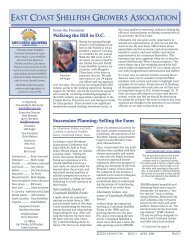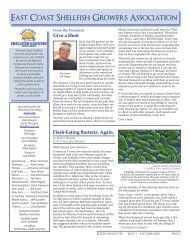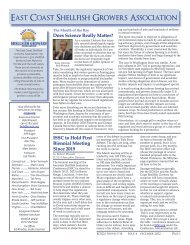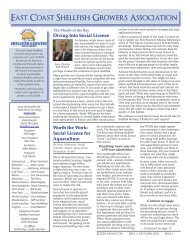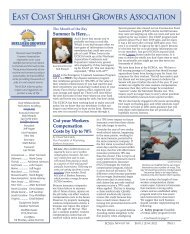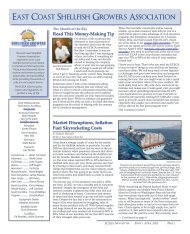East Coast Shellfish Growers Association June 2024 Newsletter
Create successful ePaper yourself
Turn your PDF publications into a flip-book with our unique Google optimized e-Paper software.
—Continued from page 14<br />
<strong>Shellfish</strong> Won’t Fix<br />
Climate Change<br />
Trees tie up carbon for many<br />
years until they die and rot or<br />
get burned. Many are touting<br />
trees as a carbon sink, but forest<br />
fires may be challenging that<br />
concept.<br />
Sequestration refers to tying up<br />
carbon in another form for long<br />
periods of time. Bivalve shell is<br />
composed of calcium carbonate,<br />
and the carbon in shell can<br />
be sequestered for up to tens of<br />
thousands of years. So why is<br />
shell not a sink? For shell to be<br />
considered a sink you would<br />
need to remove more carbon<br />
than it took to make the shell.<br />
Cement ties up tremendous<br />
amounts of carbon around the<br />
world for long periods of time,<br />
but making cement is extremely<br />
energy-intensive and requires the<br />
burning of immense amounts<br />
of fossil fuels, so cement is not a<br />
carbon sink.<br />
For starters, shellfish liberate<br />
a molecule of CO2 for every<br />
molecule of calcium carbonate<br />
they create. <strong>Shellfish</strong> also use<br />
energy to make shell, and that<br />
requires respiration, which produces<br />
CO2. Some argue that the<br />
CO2 released in respiration is<br />
immediately taken up by algae,<br />
which absorb the CO2 and make<br />
carbohydrates. Depending on<br />
your assumptions, at best the<br />
whole process is a net zero, so<br />
you can’t claim that shellfish are<br />
reducing atmospheric CO2.<br />
Removing shell from the ocean<br />
decreases the alkalinity of the<br />
seawater, which lowers the solubility<br />
of CO2 in seawater. It’s<br />
estimated that roughly a third of<br />
the CO2 produced by burning<br />
fossil fuels has dissolved into the<br />
ocean, but if we lower the alkalinity<br />
of the ocean, it incrementally<br />
pushes that CO2 back into<br />
the atmosphere. I don’t know<br />
what percentage of shell gets returned<br />
to the ocean after we eat<br />
the animals inside, but I suspect<br />
it is a pretty small fraction.<br />
Then there is the question of<br />
scale. Global emissions of CO2<br />
are approximately 37 gigatons<br />
per year. Zavell’s estimates of total<br />
global farmed-shellfish shell<br />
are on the order of 4-7 million<br />
tons produced each year. Using<br />
the higher estimate, and assuming<br />
there is no CO2 produced<br />
in making the shell, the CO2<br />
sequestered in shell represents<br />
only 0.02% of annual emissions.<br />
Doubling global production<br />
would have a negligible impact,<br />
even under an ideal scenario. It<br />
has been argued that if we could<br />
replace 10% of meat consumption<br />
with shellfish, the impact on<br />
carbon emissions would be similar<br />
to pulling 10.8 million cars<br />
off the road (Ray et al. 2019).<br />
I am all for that, but it might<br />
be a hard sell. We have a great<br />
product with a great story to tell,<br />
but let’s not stretch the truth by<br />
making claims that don’t add up.<br />
Notes<br />
1. An Estimate of Carbon Storage<br />
Capabilities from Wild and<br />
Cultured <strong>Shellfish</strong> in the Northwest<br />
Atlantic and Their Potential<br />
Inclusion in a Carbon Economy.<br />
Zavell et al. <strong>2024</strong>, Journal of<br />
<strong>Shellfish</strong> Research<br />
doi.org/10.2983/035.042.0214<br />
—Continued from page 13<br />
Traceability<br />
We have great stories to tell and<br />
there is solid evidence that this<br />
increases the value of the product.<br />
Traceability will also cut<br />
down on fraud and trademark<br />
abuse, which will go a long way<br />
toward improving customer<br />
trust.<br />
Challenges<br />
Some hardships and challenges<br />
remain for sure. Small producers<br />
and “first receivers” (who need<br />
to create lot codes) will have to<br />
absorb training and software<br />
costs and will need to adopt<br />
new protocols. Change is hard!<br />
Dealers will need to pay for<br />
scanners, software and training.<br />
The various traceability software<br />
companies offered a wide range<br />
of options and their on-boarding<br />
time estimates to get up to<br />
speed varied from 2 hours to<br />
4-6 weeks. One thing everyone<br />
agreed on is that it would be<br />
prudent to engage in traceability<br />
early so that your concerns are<br />
addressed and any regulations<br />
that are developed will fit our<br />
industry.<br />
Hyperlinks<br />
1. www.fda.gov/food/guidanceregulation-food-and-dietarysupplements/food-safetymodernization-act-fsma<br />
2. www.fda.gov/food/foodsafety-modernization-act-fsma/<br />
food-traceability-list<br />
3. www.federalregister.gov/<br />
documents//2022/11/21/<br />
2022-24417/requirementsfor-additional-traceabilityrecords-for-certain-foods<br />
ECSGA <strong>Newsletter</strong> Issue 2 <strong>June</strong> <strong>2024</strong><br />
Page 17



